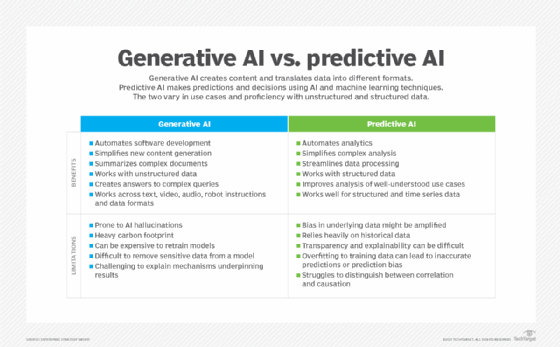Generative AI vs. predictive AI: Understanding the differences
Generative AI and predictive AI vary in how they handle use cases and unstructured and structured data, respectively. Explore the benefits and limitations of each.
Generative AI and predictive AI are both types of artificial intelligence that can help businesses become more efficient and innovative. The main differences between the two domains are use cases and proficiency with unstructured and structured data, respectively.
Generative AI creates content, code, music and marketing material and can translate data into different formats. Predictive AI makes predictions, recommendations and decisions using various AI and machine learning (ML) techniques.
Technically speaking, generative AI often uses many predictive processes to incrementally predict the next unit of content within a result.
Key differences between predictive AI and generative AI
"Generative AI and predictive AI represent distinct paradigms within the realm of artificial intelligence and machine learning," said Bharath Thota, partner in the advanced analytics practice at Kearney, a global strategy and management consulting firm.
As noted, generative AI focuses on creating new and original content, such as images, text and other media, by learning from existing data patterns. It is widely applicable across many fields, from art, music and other creative disciplines to scientific research, drug discovery, marketing and education.
This article is part of
What is GenAI? Generative AI explained
Predictive AI uses patterns in historical data to forecast future outcomes or classify future events. It provides actionable insights and aids in decision-making and strategy formulation.
"These approaches are not isolated and can prove to be symbiotic in developing an overarching business strategy," Thota said. Generative AI can help design product features, while predictive AI can forecast consumer demand or market response for these features. Generative AI can synthesize realistic data to enhance a predictive model's training set to improve predictive capabilities.
 Inna Kuznetsova
Inna Kuznetsova
Predictive AI forecasts future events by analyzing historical data trends to assign probability weights to the models. Generative AI creates new data, which might be in the form of text and images. "Think of the first [predictive AI] as a powerful analyst doing magic with numbers, while the second [generative AI] is a creative kind -- a writer, an artist or an assistant in research," said Inna Kuznetsova, CEO at ToolsGroup, a supply chain planning and optimization firm.
It's helpful to frame predictive AI as helping to predict whether a certain event will occur as a solution to a classification problem -- such as a loan default -- and forecast the quantitative impact of multiple events on continuous variables as a regression problem, such as credit card portfolio analysis, said Arun Ramchandran, president and global head, GenAI Unit, Hi-Tech & Professional Services at IT services and solutions provider Hexaware. These solutions are mostly based on structured data from past events.
 Arun Ramchandran
Arun Ramchandran
In contrast, generative AI is designed to generate novel content based on user input and the unstructured data on which it's trained. These models might provide answers, but more as an opinion with qualitative reasoning.
Ramchandran said generative AI can complement predictive AI in the enterprise to derive value from both structured and unstructured data. Here, predictive models are used to improve business processes and outcomes, while generative models are employed to meet the content requirements of those processes. However, care is required for data governance, security and privacy. In addition, this combination might be used in forecasting for synthetic data generation, data augmentation and simulations.
What is generative AI and how does it work?
Generative AI creates new content using various algorithms pioneered in the mid-2010s that have strengths for different use cases. Among these algorithms are the following:
- Generative adversarial networks to create images, synthesize voices, and translate voices and video for use in different languages.
- Variational autoencoders to generate structured data.
- Diffusion models to generate imagery and videos in response to prompts.
- Large language models (LLMs) that excel in text generation; however, newer multimodal approaches can translate across domains, such as creating images, writing code, programming robots and crafting automation in response to a text prompt.
Benefits of generative AI
Some of the key benefits of generative AI include the following:
- Automates code generation and other aspects of software development.
- Simplifies new content generation.
- Summarizes complex documents or data sets.
- Easily works with unstructured data.
- Creates articulate and simple answers to complex queries.
- Works well across different modalities such as text, video, audio, robot instructions and data formats.
Limitations of generative AI
Some of the limitations of generative AI include the following:
- Propensity to hallucinate.
- Heavy carbon footprint.
- Can be expensive to retrain models.
- Difficult to remove sensitive data once it's baked into a model.
- More challenging to explain or interpret the mechanisms underpinning results.
Generative AI applications in business
Some of the most common generative AI applications in business include the following:
- Generating code.
- Crafting marketing materials.
- Searching multiple manuals.
- Personalizing content for customers and employees.
- Customizing learning experiences.
- Translating data across formats.
- Customizing explanations for different levels of expertise or roles.
- Localization of content across different geographies and languages.
- Researching complex topics.
- Distilling and summarizing risks across different domains in risk management.
- Summarizing resumes to streamline candidate selection.
- Managing skills taxonomies in learning and development.
- Summarizing patterns in call center interactions.
- Simplifying complex UIs to simple text prompts.
What is predictive AI and how does it work?
"Predictive AI focuses on making decisions based on historical data and current information," said Owen Morris, CTO at cloud consultancy Doherty Associates.
 Owen Morris
Owen Morris
It's used in various applications such as predicting financial market trends, equipment maintenance scheduling and anomaly detection. Predictive AI offers great value across different business applications, including fraud detection, preventive maintenance, recommendation systems, churn prediction, capacity management and logistics optimization.
Predictive AI uses most ML and AI algorithms outside the scope of those used for generative AI, including the following:
- Neural networks for a variety of tasks.
- Linear regression to find correlations.
- Logistic regression to classify data.
- Support vector machines to classify data.
- Decision trees to estimate outcomes.
- Random forests to classify data.
- K-means clustering to sort data into groups.
- Self-trained naive Bayes classifier to classify data.
Benefits of predictive AI
Some of the benefits of predictive AI include the following:
- Automates analytics.
- Simplifies complex analysis.
- Streamlines data processing.
- Works with structured data.
- Can improve analysis for well-understood use cases.
- Works well for structured and time series data.
Limitations of predictive AI
"While predictive AI emerged as a game changer in the analytics landscape, it does have limitations within business operations," Thota said. Understanding and addressing these limitations can help businesses safeguard themselves from these pitfalls. This often involves combining predictive AI with other analytics techniques to mitigate weaknesses.
Some of the limitations of predictive AI include the following:
- Bias in underlying data might be amplified. This might lead to inconsistencies in interpretation and ethical concerns. Ramchandran recommends adopting stringent data and model governance practices to reduce these risks.
- Overreliance on historical data. Thota said training data should be augmented with real-time and external data sources and feedback loops to update models with recent information.
- Lack of interpretability can arise in complex predictive models. These models, built on deep neural networks, can make transparency and explainability difficult. The use of simpler models can help identify and fix issues that arise. Kuznetsova said businesses should consider explainable AI techniques to help business leaders understand how the models work and make predictions.
- Overfitting. When an AI model tries to fit itself to the training data too closely, it can lead to inaccurate predictions.
- Struggle with causation. Predictive models are good at identifying correlation, but they can struggle to distinguish between correlation and causation. Thota said causal inference methods and randomized controls can help differentiate between correlation and causation.
- Too much training on data and business cases can lead to prediction bias. Kuznetsova recommends questioning the number of cases analyzed for an industry subsegment. "What may work very well in groceries, with a shorter shelf life but less variety of models and sizes, may not be successful in forecasting demand in apparel or footwear," she said.

Predictive AI applications in business
Morris said some best practices to ensure organizations get the most value from predictive AI in business include setting clear objectives and KPI definitions and ensuring data quality. It's also important to monitor results to ensure models perform as needed and to review model factors periodically to identify outdated factors and potential biases.
Businesses can use predictive AI in the following ways:
- Demand sensing and forecasting. Predictive AI uses historical and causal data to create a more accurate short-term granular demand forecast to support inventory location and allocation decisions.
- Inventory optimization. An analytic approach that incorporates predictive AI to better identify and set inventory targets throughout all inventory locations and types in the supply chain.
- Customer targeting. Predictive AI analyzes historical data to predict which customers are likely to respond positively to specific offers or promotions.
- Risk assessment. Financial institutions and lenders widely use predictive AI to evaluate fiscal and credit risks related to defaults or delinquencies.
- Sales forecasting. Forecasting future sales based on historical data, market trends and external factors helps companies allocate resources, manage demand planning and supply chain operations, and optimize inventory levels.
- Churn prevention. Predictive AI can analyze historical interactions and other customer demographic data to predict customers likely to churn, which lets companies make proactive retention efforts.
- Preventive maintenance. This can help optimize maintenance schedules to reduce costs while reducing the risk of failures.
Editor's note: This article was updated in November 2024 to improve the reader experience.
George Lawton is a journalist based in London. Over the last 30 years he has written over 3,000 stories for publications about computers, communications, knowledge management, business, health and other areas that interest him.








